All About Crawlspace: Drying Methods, Maintennce, and Repairs

The definition of crawlspace is a shallow, accessible underfloor space located between the ground and the first floor of a building. It helps prevent moisture intrusion, supports ventilation under the home, and provides access to critical building systems. Crawlspace is mainly of two types: vented and unvented.
Crawlspace can be damaged by water-related issues such as standing water, seepage, plumbing leaks, condensation on the surface, ground water intrusion, failed drainage systems, water vapor rises, and backflow from gutters and downspouts. The excessive water produces moisture and causes mold and mildew growth, wood rotting, rust and corrosion, musty odor, condensation on ducts, and pest infestation in the crawlspace.
To prevent these water damages, crawlspace should be ventilated properly. To keep the crawlspace more ventilated and dry, you should install a vapor barrier, encapsulate the crawlspace, improve the drainage system, install a dehumidifier, seal the vents, insulate the crawlspace, and maintain gutters and downspouts near the crawlspace.
More than that, Aqviz experts recommend maintaining a crawlspace and conducting essential repairs to prevent damage to the sealed and protected crawlspaces. We strongly advise you to inspect the crawlspace regularly to identify the problems, damages and address them on time to maintain a healthy crawlspace. So Aqviz experts are always ready to support you. Contact us today!
What Is the Definition of Crawlspace?
The definition of crawlspace is a shallow, accessible underfloor space located between the ground and the first floor of a building. A crawlspace is typically 18 inches (457 mm) to 48 inches (1.22 m) in height. The main purpose of a crawlspace is to form a protective gap between the soil and the structure’s foundation. It helps prevent moisture intrusion, supports ventilation under the home, and provides access to critical building systems.
This underfloor space provides a hidden area that contains essential utilities such as plumbing pipes, gas lines, electrical wiring, and HVAC ducts. A crawlspace does not offer standing room like a basement but allows limited access for inspections, repairs, and maintenance.
More than that, it helps to reduce the termite risk by keeping wood framing off the soil, creating a thermal buffer that improves energy efficiency, and allowing easier retrofitting for upgrades such as insulation or ductwork repairs. This space also helps in managing the soil movement effects on the foundation.

What Are the Types of Crawlspaces?
Crawlspaces are mainly two types: vented crawlspace and unvented crawlspace.
A vented crawlspace includes openings along the foundation walls that allow outdoor air to flow through and help control moisture. This crawlspace design was common in older construction, but we have seen it often fail in humid regions where it leads to condensation and mold growth.
An unvented crawlspace, also called a sealed crawlspace, is enclosed with vapor barriers and insulation to block moisture and air infiltration. Based on our experience, an unvented crawlspace is the better choice for most homes because it offers stronger moisture protection, enhanced energy efficiency, and reduced pest intrusion.
What Are the Common Water Related Issues in Crawlspace?
There are 8 common water-related issues in a crawlspace that we often encounter during inspections and repairs.
- Standing water accumulation: Water pooling on the crawlspace floor due to poor site drainage, heavy rainfall, or high water table conditions.
- Seepage through foundation walls: Water infiltrating the crawlspace through cracks, gaps, or porous concrete block walls, particularly during storms or flooding events.
- Plumbing leaks: Water leaking from pipes, joints, or fittings that pass through the crawlspace, creating constant moisture exposure over time.
- Condensation on surfaces: Moisture forming on crawlspace ducts, pipes, or insulation as a result of high humidity and temperature differences.
- Groundwater intrusion: Water entering the crawlspace from beneath the soil, usually caused by inadequate grading or a failed sump pump system.
- Drainage system failure: Water backing up into the crawlspace due to clogged or broken perimeter drains or French drains.
- Water vapor rises from the soil: Moisture evaporating from exposed soil in the crawlspace, increasing humidity, and contributing to condensation.
- Backflow from gutters or downspouts: Water from misdirected roof runoff accumulates around the foundation and seeps into the crawlspace.
What Are the Signs of Moisture Damage in Crawlspace?
There are 7 clear signs of moisture damage in the crawlspace that indicate a need for immediate action to prevent further structural harm and health risks.
- Mold and mildew growth : The presence of fungal patches on wood framing, insulation, or foundation walls in the crawlspace indicates excessive moisture levels. This growth is often observed in dark corners and on organic materials.
- Wood rot : Soft, crumbling, or discolored wood joists, beams, or subflooring in the crawlspace shows evidence of prolonged exposure to damp conditions that weaken structural components.
- Rust and corrosion : Rust spots and corrosion on metal pipes, fasteners, and ductwork confirm that moisture is condensing on these surfaces inside the crawlspace.
- Musty odor : A persistent, unpleasant smell rising from the crawlspace indicates trapped moisture and possible microbial growth that affects indoor air quality.
- Condensation on pipes and ducts : Water droplets forming on pipes, ductwork, or insulation within the crawlspace show that humidity is high enough to trigger condensation.
- Foundation cracks : Small or large cracks visible on foundation walls provide evidence of moisture weakening the masonry or concrete, contributing to structural movement.
- Pest infestation : The presence of termites, carpenter ants, or rodents observed inside the crawlspace indicates that moist conditions are attracting pests that damage wood and insulation.
Read More About:
- Crawl Space Mold: Warning Signs, Damage and Removal Tips
- Crawl Space Flooding: Causes, Warning Signs and How to Fix
- Crawl Space Humidity: Ideal Levels, Damage Risks and Fixes
- Musty Crawl Space: Signs, Risks and Solutions
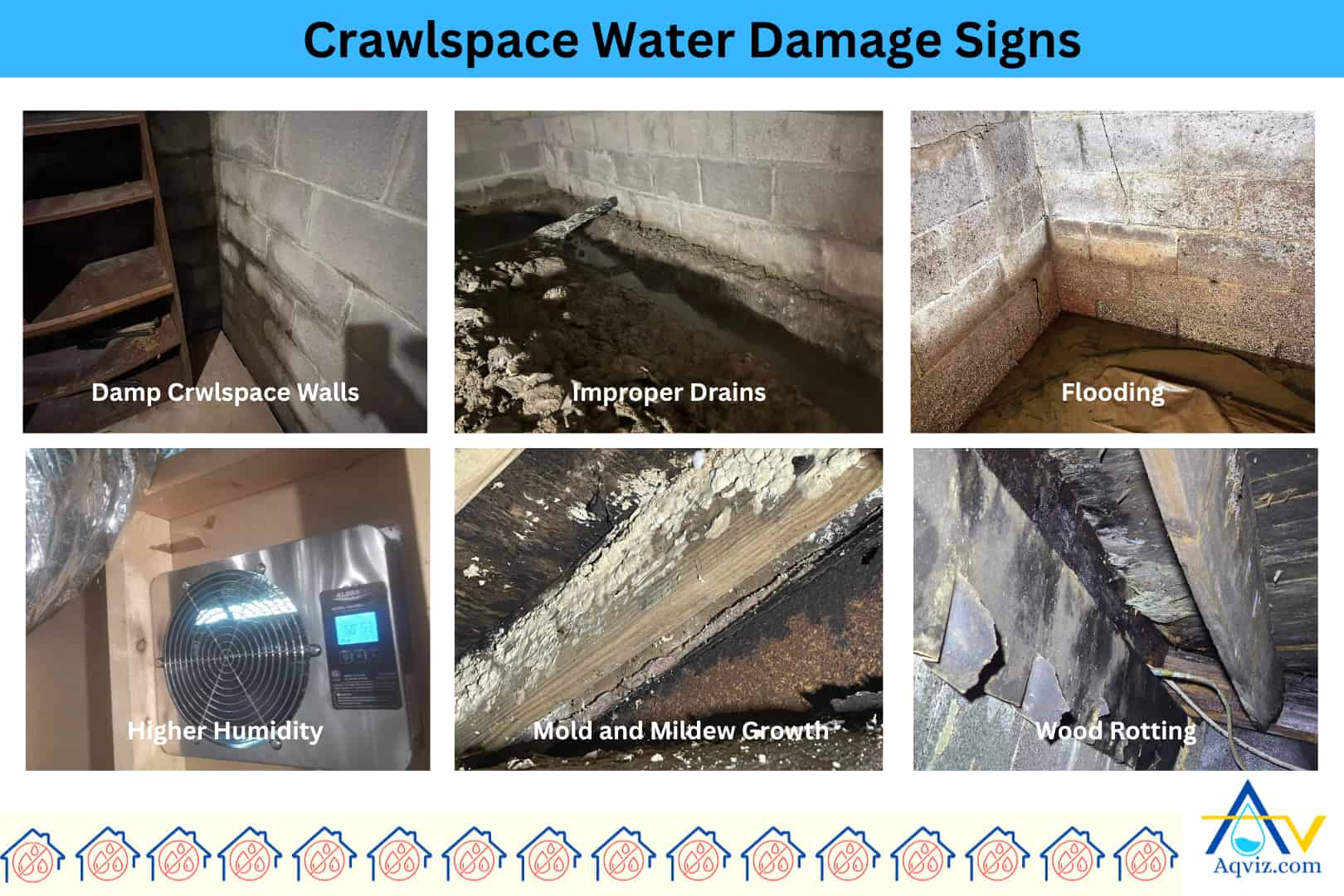
What Is the Importance of Crawlspace Ventilation?
The importance of crawlspace ventilation is to regulate moisture levels and improve air circulation within the crawlspace, which helps prevent the buildup of humidity that can lead to mold, mildew, and wood rot. Proper ventilation reduces condensation on pipes, ducts, and insulation, protecting mechanical systems and structural components from water-related damage.
Crawlspace ventilation also helps control temperature extremes under the home, minimizes the risk of pest infestations, and improves overall indoor air quality. Effective crawlspace ventilation is critical for prolonging the life of the foundation and maintaining a healthier, more energy-efficient living environment above the crawlspace.
How to Keep Crawlspace Dry?
Aqviz experts use these 8 effective ways to keep the crawlspace dry, and each method plays a specific role in controlling moisture and protecting the structure from water damage.
Install a Vapor Barrier in the Crawlspace
Installing a vapor barrier in the crawlspace is an important step for controlling moisture and protecting the structure from water-related damage. A vapor barrier is typically a durable polyethylene sheet with a minimum thickness of 6 mil (0.15 mm), laid over the soil surface and sealed to foundation walls and piers. This barrier prevents water vapor from rising through the soil and contributing to high humidity levels in the crawlspace.
A vapor barrier installation in the crawlspace helps reduce condensation, prevent mold and mildew growth, and improve indoor air quality. The vapor barrier also enhances energy efficiency by minimizing moisture-related heat loss and protects wood framing from rot. For the best results, the vapor barrier should cover 100% of the crawlspace floor and extend at least 6 inches (152 mm) up the foundation walls, with all seams overlapped and sealed tightly.

Encapsulate the Crawlspace
Encapsulating the crawlspace involves completely sealing the crawlspace using a heavy-duty vapor barrier, rigid foam insulation, and airtight covers for vents and access doors. The encapsulation system typically uses a reinforced polyethylene liner, 12 mil (0.3 mm) or thicker, that covers the entire crawlspace floor, foundation walls, and piers. All seams are overlapped and sealed with tape or adhesive, and the liner is mechanically fastened to the walls.
Encapsulation in the crawlspace creates a controlled environment that blocks moisture, improves energy efficiency, and prevents mold, mildew, and pest infestations. Encapsulation also reduces drafts and improves indoor air quality by isolating the crawlspace from outside air and soil gases. For added protection, a dehumidifier is often installed to maintain optimal humidity levels below 60%.

Improve Crawlspace Drainage System
Improving the crawlspace drainage system is essential for managing water intrusion and preventing standing water that leads to structural damage and mold growth. An effective drainage system in the crawlspace typically includes installing a perimeter trench with a perforated French drain or corrugated drainage pipe that channels water to a reliable sump pump . The system collects and directs water away from the foundation, keeping the crawlspace dry.
Upgrading the crawlspace drainage system also involves ensuring proper exterior grading, adding downspout extensions, and maintaining gutters to prevent water accumulation near the foundation. A well-designed crawlspace drainage system significantly reduces groundwater intrusion and protects the crawlspace from long-term moisture damage.
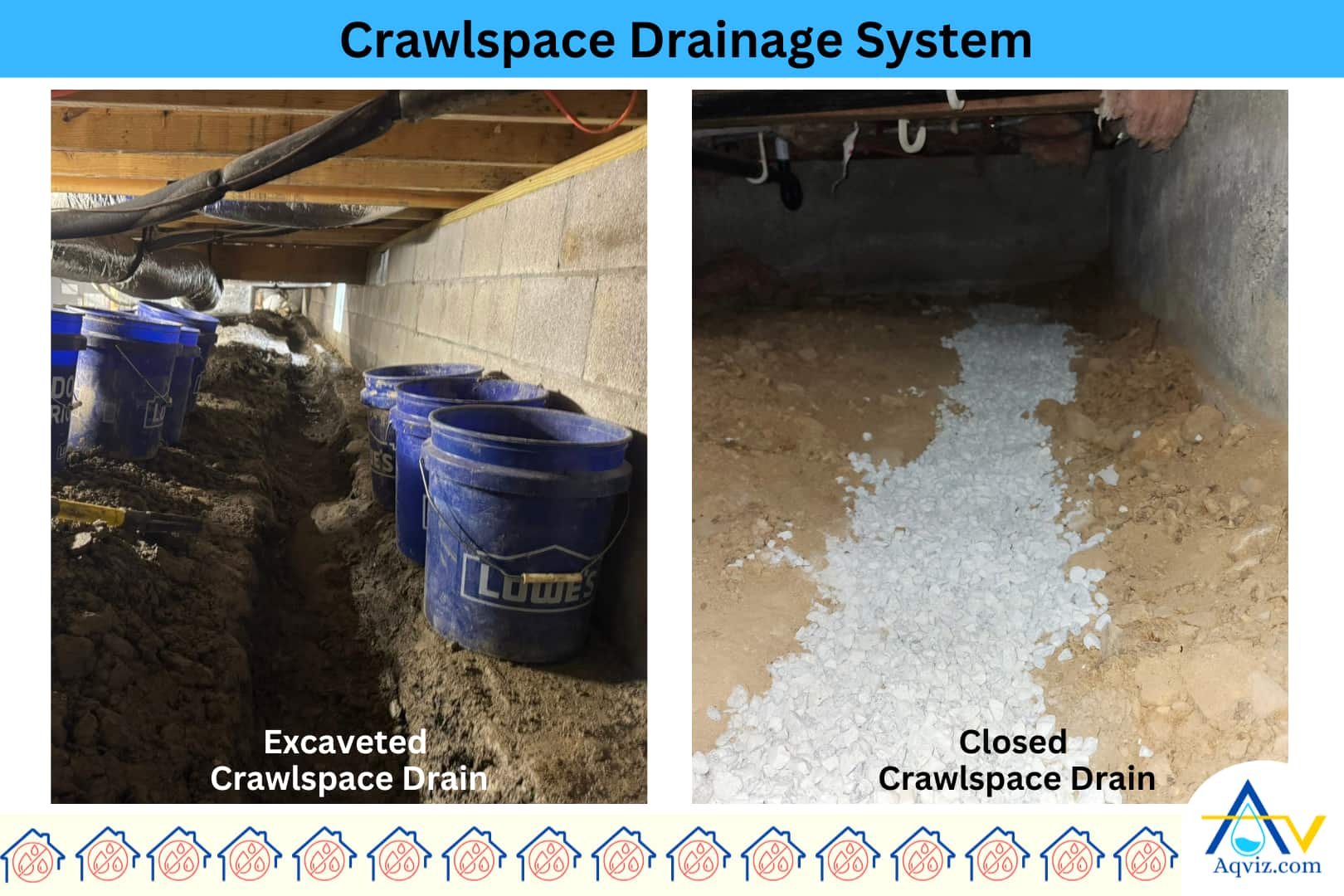
Install a Dehumidifier in the Crawlspace
Installing a dehumidifier in the crawlspace involves placing a mechanical unit designed to control and maintain the humidity level below 60%. The dehumidifier in the crawlspace continuously extracts moisture from the air, collecting it in a reservoir or directing it to a drain or sump pump. A crawlspace dehumidifier is typically equipped with an automatic humidistat to regulate operation based on the humidity level.
A dehumidifier in the crawlspace helps keep the crawlspace dry by reducing excess moisture in the air, preventing condensation on pipes, insulation, and wood framing. This reduces the risk of mold growth, wood rot, and pest infestations while improving the indoor air quality in the living space above the crawlspace.
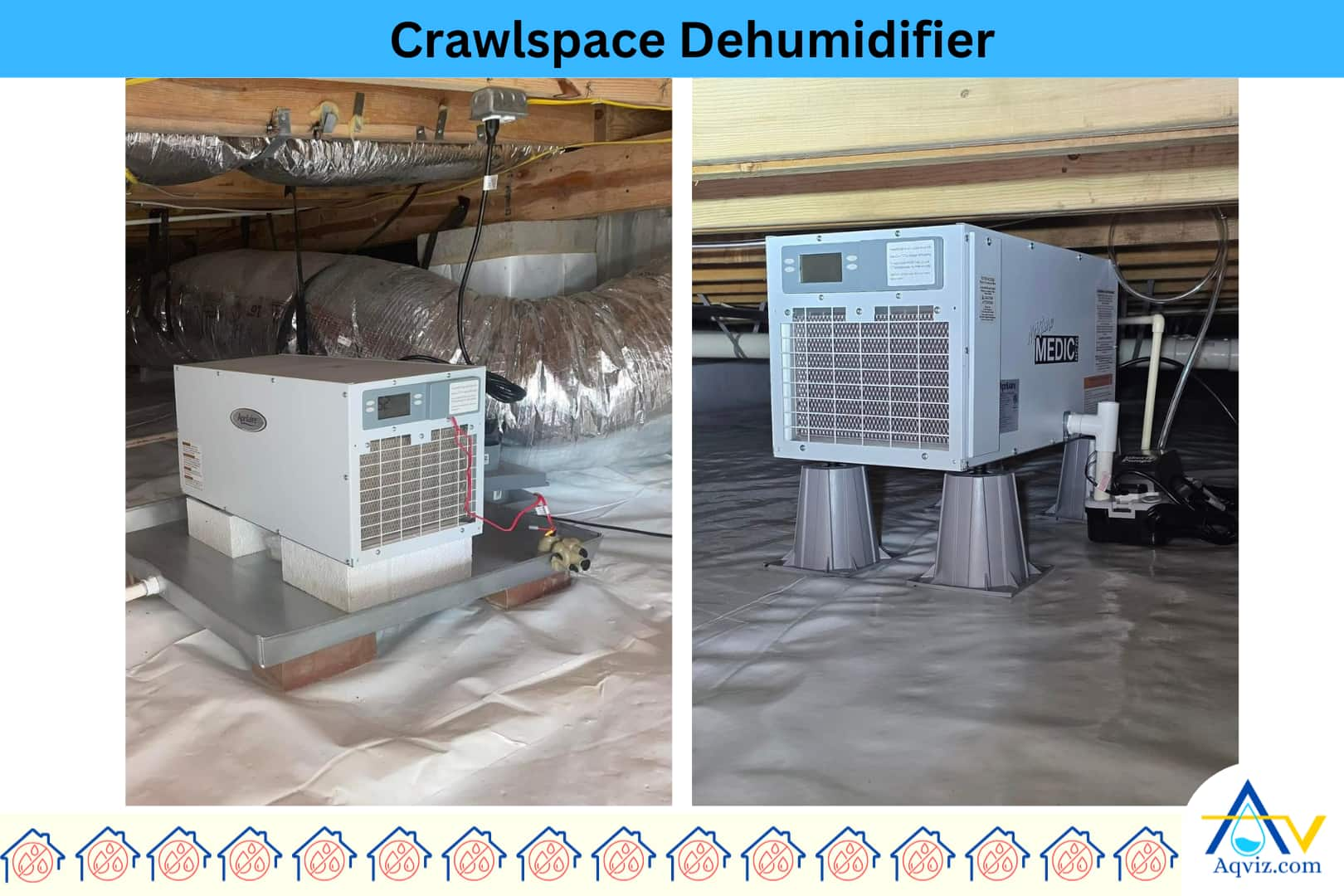
Seal the Crawlspace Vents
Sealing the crawlspace vents involves closing or covering the foundation vent openings using durable materials such as rigid foam panels, masonry, or vent covers designed for airtight sealing. Crawlspace vent sealing eliminates direct air exchange between the crawlspace and the exterior, which is a common source of moisture and unconditioned air infiltration.
Sealing the crawlspace vents helps keep the crawlspace dry by blocking humid outdoor air from entering and condensing on cool surfaces. This prevents moisture buildup, reduces the risk of mold growth, and contributes to stable humidity levels. Sealed vents also improve energy efficiency by minimizing drafts and heat loss through the crawlspace.
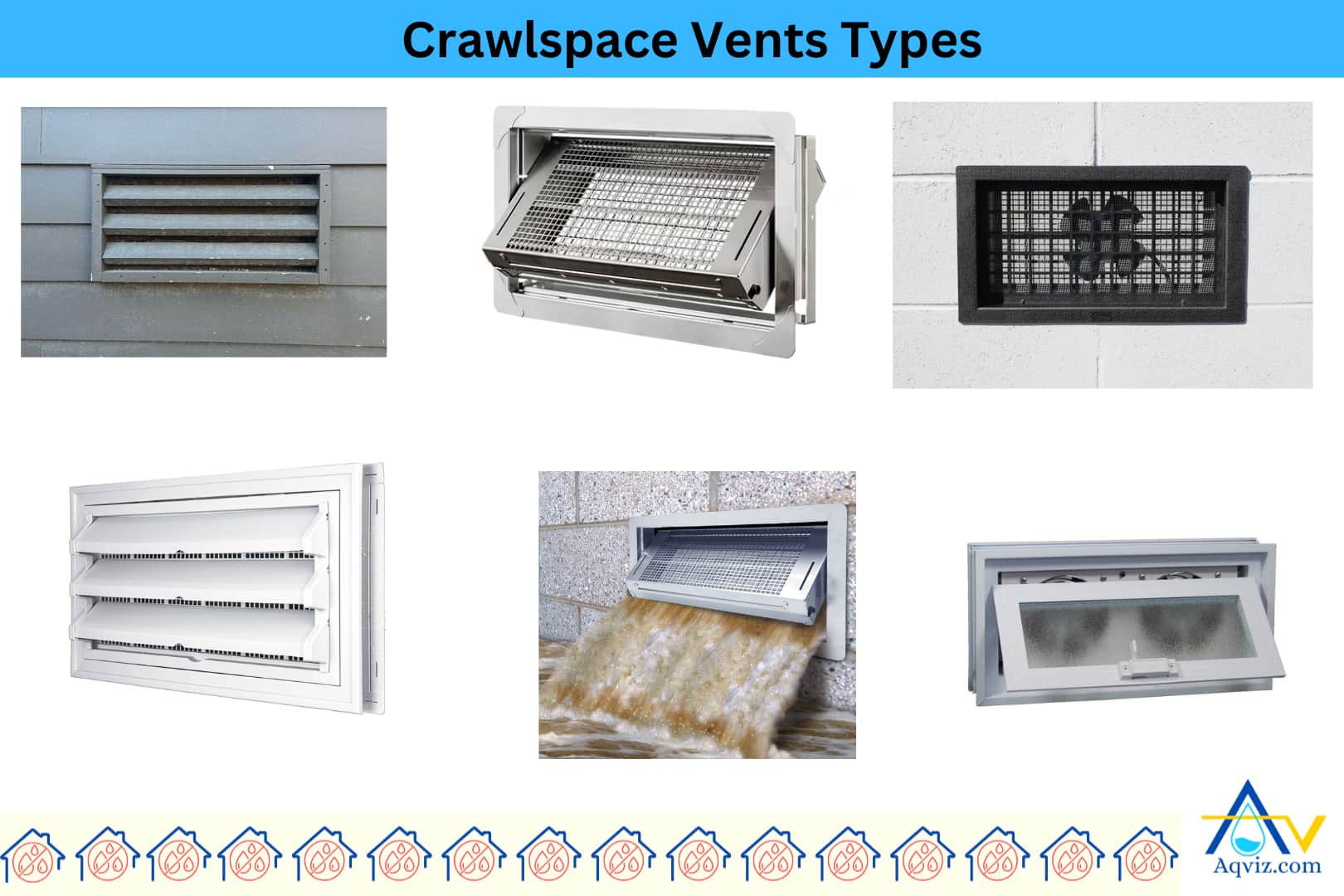
Insulate the Crawlspace
Insulating the crawlspace involves applying thermal insulation materials such as rigid foam boards, spray foam, or fiberglass batts to the foundation walls or the underside of the subfloor. The insulation is typically installed in sealed and encapsulated crawlspaces to enhance thermal performance and moisture control. Rigid foam boards are widely preferred for their moisture resistance and durability.
Insulating the crawlspace helps keep the crawlspace dry by reducing temperature fluctuations that contribute to condensation on pipes, ducts, and wood framing. The insulation also helps lower energy costs, prevent cold floors, and protect the structure from moisture-related damage linked to thermal bridging and humidity spikes.
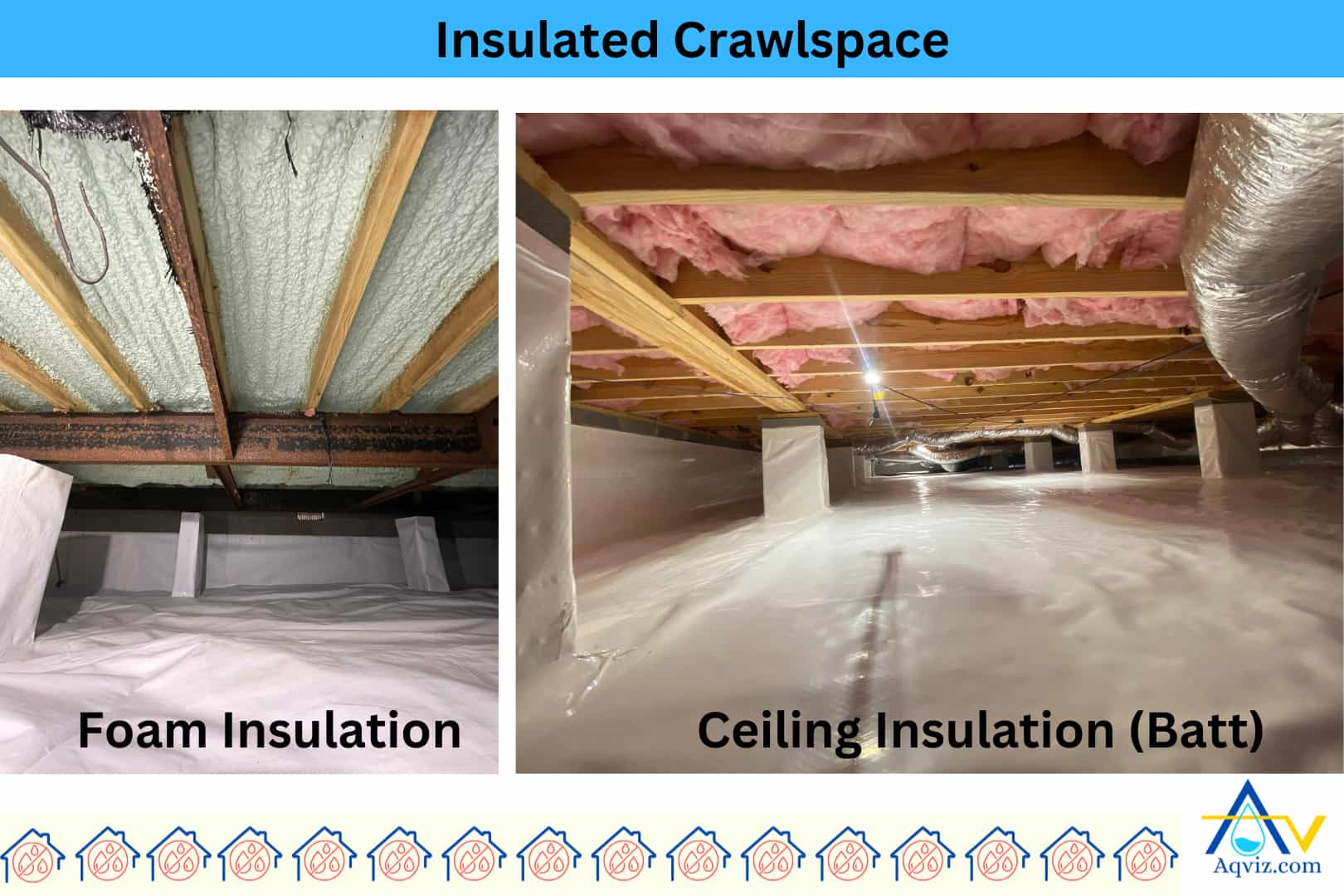
Maintain Gutters and Downspout Near the Crawlspace
Maintaining gutters and downspouts near the crawlspace involves regularly cleaning debris, checking for leaks, and ensuring all components direct water at least 1.5 meters (5 feet) away from the foundation. Extensions, splash blocks, or underground drainpipes can be added to downspouts to improve water discharge.
Properly maintained gutters and downspouts help keep the crawlspace dry by preventing roof runoff from pooling around the foundation. This reduces the risk of water seeping into the crawlspace through cracks or gaps in the foundation walls, helping protect against standing water, soil saturation, and moisture-related damage inside the crawlspace.
How to Maintain a Crawlspace?
Aqviz experts recommend the following steps to maintain the crawlspace to protect against moisture and structural damage.
- Inspect for moisture quarterly if your region has high rainfall
- Check the vapor barrier integrity twice a year if you have encapsulation
- Test crawlspace sump pump functionality before storm seasons
- Clean and clear drainage systems every 6 months
- Monitor humidity levels monthly if you use a dehumidifier
- Seal gaps and cracks annually if pests or drafts occur
- Check the insulation condition each winter if your crawlspace is unheated
- Verify proper grading of soil around the foundation each spring
What are the Essential Repairs in the Crawlspace?
- Replace rotten or warped floor joists in the crawlspace
- Repair or replace the damaged crawlspace vapor barrier if torn or incomplete
- Fix foundation cracks if water seeps through the walls
- Remove and replace mold-contaminated insulation in the crawlspace if growth exceeds 10 square feet
- Re-level crawlspace support piers or columns if floors sag more than 1 inch over 10 feet
- Replace damaged or clogged drainage systems if water pools in the crawlspace
- Seal air leaks and repair crawlspace vent screens if pests or external air infiltrate
What Are the 7 Ways That Can Damage the Crawlspace Protection?
In our past 15+ experience, we found that these 7 are the main ways that can damage the crawlspace protection and lead to serious moisture problems, structural damage, and reduced energy efficiency.
- Clogged or damaged gutters and downspouts: Gutters and downspouts that fail to divert water away from the foundation allow roof runoff to pool near the crawlspace, increasing the risk of water intrusion.
- Poor landscape grading: A yard that slopes toward the foundation directs rainwater into the crawlspace, overwhelming drainage systems and promoting seepage.
- Broken or missing vapor barrier: Tears, gaps, or improper installation of the vapor barrier allow water vapor from the soil to rise into the crawlspace and raise humidity levels.
- Unsealed or damaged crawlspace vents: Open or broken vents permit humid outdoor air and pests to enter, leading to condensation and infestations.
- Plumbing leaks inside the crawlspace: Leaks from pipes or fittings add constant moisture that can saturate insulation, rot wood framing, and create conditions for mold growth.
- Failed or inadequate drainage system: A broken, clogged, or poorly designed drainage system causes water to accumulate around or inside the crawlspace.
- Improper encapsulation or insulation: Incomplete or poorly installed encapsulation or insulation leaves gaps where moisture can enter, undermining the protection system.
What is Crawlspace Waterproofing?
Crawlspace waterproofing is the process of preventing water, moisture, and humidity from entering the underfloor area located between the soil and the ground floor of a building. Crawlspace waterproofing includes crawlspace inspection, cleaning, sealing vents, improving drains, sealing cracks and damages, installing a vapor barrier, adding insulation, and installing a dehumidifier.
How often Should I Inspect my Crawlspace?
You should inspect your crawlspace at least twice a year. You should inspect once in the spring and once in the fall. And also crawlspace should be inspected after heavy rain, high humidity periods, dry spells, or droughts, and pest season for the best evaluations. You should use a crawlspace inspection check list to prevent missing any step during the checking process.
Download the crawlspace inspection checklist here.
Do I need a Vapor Barrier if my Crawlspace is Already Dry?
Yes, installing a vapor barrier is recommended even if the crawlspace appears dry during inspection. A vapor barrier provides continuous protection by preventing water vapor from rising through the soil and creating hidden moisture issues over time. Dry conditions today do not confirm that the crawlspace will stay dry during heavy rain, seasonal changes, or fluctuations in groundwater levels.
Is It Better to Have a Vented or Sealed (Unvented) Crawlspace?
A sealed (unvented) crawlspace is generally better than a vented crawlspace, based on our direct observations and project outcomes. A sealed crawlspace uses vapor barriers, sealed vents, and insulation to block external air and moisture. This approach helps maintain consistent humidity levels, prevents condensation, and protects wood framing and mechanical systems from water-related damage.
How Do Pests Get Into Crawlspaces?
Pests get into crawlspaces through gaps, cracks, and openings that provide direct entry from the exterior. Damaged or missing vent screens, poorly sealed crawlspace doors, and unsealed utility penetrations often indicate easy access points that pests exploit. Small rodents, termites, carpenter ants, and other insects observe these weak areas and enter in search of shelter, food, and moisture.
